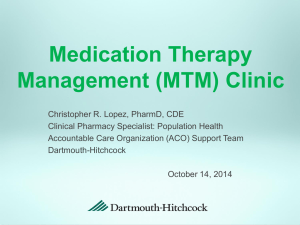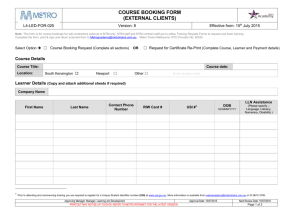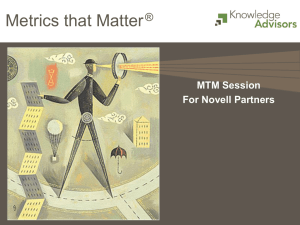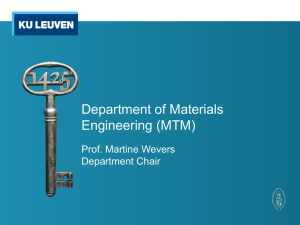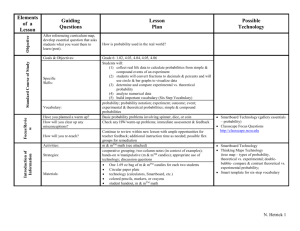Appendix - B - Community Pharmacy Foundation
advertisement
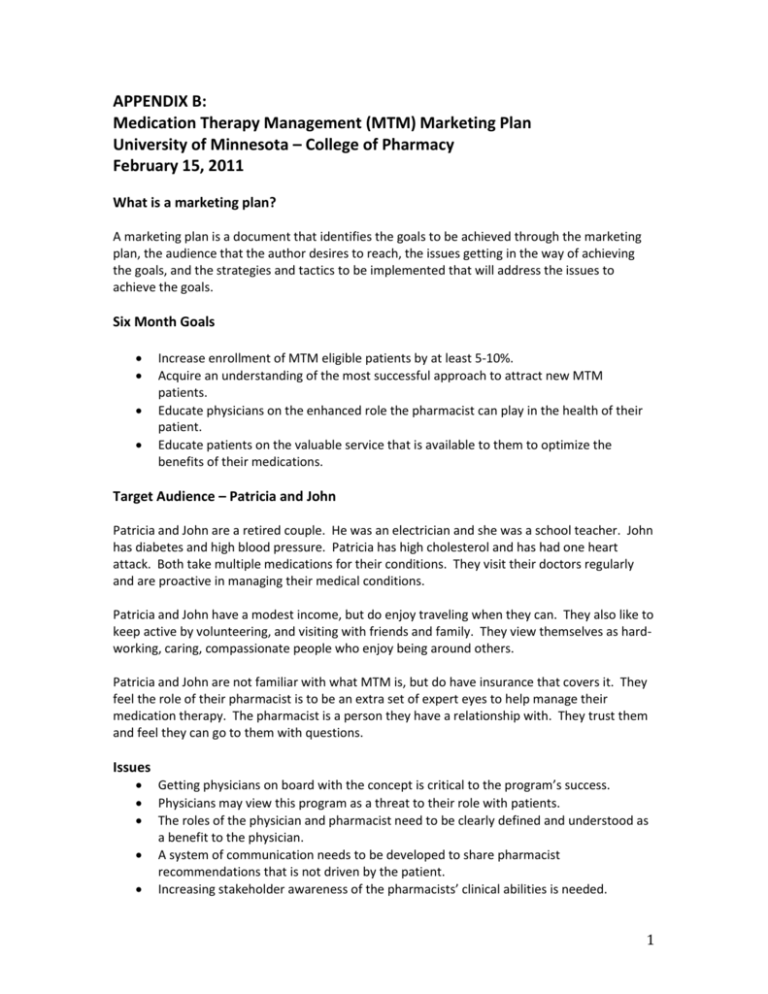
APPENDIX B: Medication Therapy Management (MTM) Marketing Plan University of Minnesota – College of Pharmacy February 15, 2011 What is a marketing plan? A marketing plan is a document that identifies the goals to be achieved through the marketing plan, the audience that the author desires to reach, the issues getting in the way of achieving the goals, and the strategies and tactics to be implemented that will address the issues to achieve the goals. Six Month Goals Increase enrollment of MTM eligible patients by at least 5-10%. Acquire an understanding of the most successful approach to attract new MTM patients. Educate physicians on the enhanced role the pharmacist can play in the health of their patient. Educate patients on the valuable service that is available to them to optimize the benefits of their medications. Target Audience – Patricia and John Patricia and John are a retired couple. He was an electrician and she was a school teacher. John has diabetes and high blood pressure. Patricia has high cholesterol and has had one heart attack. Both take multiple medications for their conditions. They visit their doctors regularly and are proactive in managing their medical conditions. Patricia and John have a modest income, but do enjoy traveling when they can. They also like to keep active by volunteering, and visiting with friends and family. They view themselves as hardworking, caring, compassionate people who enjoy being around others. Patricia and John are not familiar with what MTM is, but do have insurance that covers it. They feel the role of their pharmacist is to be an extra set of expert eyes to help manage their medication therapy. The pharmacist is a person they have a relationship with. They trust them and feel they can go to them with questions. Issues Getting physicians on board with the concept is critical to the program’s success. Physicians may view this program as a threat to their role with patients. The roles of the physician and pharmacist need to be clearly defined and understood as a benefit to the physician. A system of communication needs to be developed to share pharmacist recommendations that is not driven by the patient. Increasing stakeholder awareness of the pharmacists’ clinical abilities is needed. 1 Differentiating prescription counseling from MTM, people have no concept of what to expect from an MTM session. There is a huge educational component to this program. o To physicians value of working together with the pharmacist for the benefit of the patient role that the pharmacist is capable of playing o To consumers benefits of the program support of physicians coverage by Medicare Part D role that the pharmacist is capable of playing Key Messages Key messages are important in the communication of the benefits of the program. Messages have to meet three criteria. They must be relevant, believeable and distinctive. The following are the top three messages identified by focus group participants as meeting the criteria. Use of these messages in the verbal and written language you use to describe MTM will resonate with your audience. Key messages are: Optimizes the safe and effective use of medications Improves my treatment outcomes Improves my quality of life Strategies and Tactics Step 1 - Product One of the aspects of a successful program is a visible relationship between the physician and the pharmacist. The patient has a strong belief that the physician is the leader of the team. The pharmacist plays more of a specialist role. An MTM meeting includes a review of the medication list and of medical issues, discussion of drug related issues/concerns, and recommendations for change. MTM consists of an initial visit. Subsequent visits occur when the patient has a change in their medical situation or when another medication is added to their list. “Medication Therapy Management” is not an appealing name. The recommendation is to drop “Therapy.” 1. Determine a name for your program – Medication Therapy Management, Medication Management, Medication Check-up are a few possible names. 2. Establish protocols for the patient meeting and physician follow-up. 2 Document these protocols as they will be valuable in talking with physicians and other interested parties. 3. Establish a tickler system that prompts you when an MTM patient has a new medication (for follow-up MTM sessions) When prompted, contact the patient and suggest a date and time to get together for a review. Step 2 - Price Based on the research conducted, it is not very likely that consumers will pay for this service out of their pocket. Therefore, the focus should be on recruiting patients that have insurance coverage for the service. Cost for MTM services should be calculated in accordance with the guidelines provided by the individual companies. 1. Investigate which insurance companies provide reimbursement for MTM consultations. 2. Identify, based on the program, what you will charge for the consultation. Step 3 - Place From the consumers point of view, where the MTM session is conducted is not a particular issue. If it makes sense, consultations could be done in the patient’s doctor’s office. Or, it could be done in the pharmacy. What is required is a private, enclosed space. 1. Define a designated space to conduct MTM sessions. 2. Identify patients from your database that would be good candidates for MTM. They are: Taking multiple medications Have insurance coverage for MTM visits Have a good working relationship with your pharmacy Have a physician that you feel is already, or would be, supportive of the program Step 4 - Promotion Awareness for what an MTM program is is very low. In the initial stages of a program launch, you will need to educate your audience. A critical factor is the visible relationship between pharmacist and physician. Getting the support of the physician with their patients will increase the participation rate. Tactics for a new MTM program: 1. Create a brochure or information flier as a leave behind piece when talking with physicians about the program. The piece could also be used by physicians to recommend MTM to patients. Benefits of MTM How MTM is different than pharmacist consultation What the process is 2. Work with local physicians to get support for conducting MTM sessions with their patients whom you have identified. 3 Conduct in-service sessions to educate doctors on the benefit of MTM for them, and protocols for patient meetings and physician follow-up 3. Schedule follow-up meetings with physicians that attend the in-service to talk with them about specific patients that could benefit from an MTM consultation. Determine who will contact the patient to schedule a meeting. Face-to-face or phone call contact from either the pharmacist or physician is best. It sends the message that MTM is important 4. If a patient is on your target list, talk to them when they are in the pharmacy to pick up a prescription. Assuming you have the support of local physicians, the next level of marketing can be focused on enhancing awareness directly with patients. Tactics to enhance an existing MTM program: 1. Increase awareness of what MTM is with local service clubs, senior centers, or associations whose members fit the target audience profile Create a short 15 minute presentation that talks about what MTM is, the benefits of MTM, what an MTM consultation consists of, and some examples of how it has helped your patients. Utilize the MTM DVD that has been provided with this plan as an additional source of information for your audience. Get a commitment for a date to speak to the group. o Talk with the head of the organization and ask to be a speaker at a membership meeting 2. Add information regarding your MTM program to your website. 3. Utilize bag stuffers, buttons, and in-store posters to raise awareness of your MTM program. Reporting Requirements From March 1 to September 1 you are participating in this pilot program. You will be in contact with Julie Hedlund and Brian Isetts on a monthly basis to discuss what is working, what’s not, what needs more support. In order to facilitate these discussions, we ask that you document your experiences on a weekly basis. In between our monthly calls, if you feel you have an issue that needs more immediate attention, please feel free to contact us at the numbers below. Brian Isetts Julie Hedlund 651-301-1804 (c) 507-424-2802 (o), or 507-254-2056 (c) 4

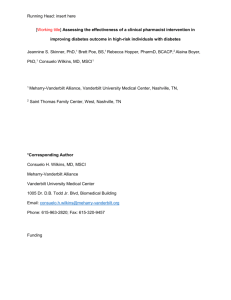
![Masood Textile Mills [Erum Zahoor]](http://s2.studylib.net/store/data/005544654_1-c63f8378e6188468be9b937fd88ad22c-300x300.png)
